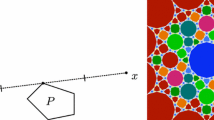Abstract
In Fragnelli et al. (TOP 22:892–933, 2014; TOP 24:88–130, 2016), we considered a bankruptcy problem with the additional constraint that the estate has to be assigned in integer unities, allowing for non-integer claims; we dealt with the extension to our setting of the constrained equal losses solution and of the constrained equal awards solution. Here, we analyze the possibilities of extending the Talmud solution to the integer situation, starting from the existing approaches for the non-integer case; some of these approaches are compatible with the non-integer claims, but in order to comply with as much as possible of the approaches it is necessary to switch to integer claims.


Similar content being viewed by others
References
Aumann RJ, Maschler M (1985) Game theoretic analysis of a bankruptcy problem from the Talmud. J Econ Theory 36:195–213
Fragnelli V, Gagliardo S, Gastaldi F (2014) Integer solutions to bankruptcy problems with non-integer claims. TOP 22:892–933
Fragnelli V, Gagliardo S, Gastaldi F (2016) Bankruptcy problems with non-integer claims: definition and characterizations of the ICEA solution. TOP 24:88–130
Herrero C, Martinez R (2004) Egalitarian rules in claims problems with indivisible goods. IVIE-WP-AD 2004-20, pp 1–24
Herrero C, Martinez R (2008a) Up methods in the allocation of indivisibilities when preferences are single-peaked. TOP 16:272–283
Herrero C, Martinez R (2008b) Balanced allocation methods for claims problems with indivisibilities. Soc Choice Welf 30:603–617
Herrero C, Villar A (2001) The three musketeers: four classical solutions to bankruptcy problems. Math Soc Sci 42:307–328
Kaminski MM (2000) ‘Hydraulic’ rationing. Math Soc Sci 40:131–155
Kaminski MM (2006) Parametric rationing methods. Games Econ Behav 54:115–133
Lucas-Estañ MC, Gozalvez J, Sanchez-Soriano J (2012) Bankruptcy-based radio resource management for multimedia mobile networks. Trans Emerg Telecommun Technol 23:186–201
Moulin H (2000) Priority rules and other asymmetric rationing methods. Econometrica 68:643–684
O’Neill B (1982) A problem of rights arbitration from the Talmud. Math Soc Sci 2:345–371
Rawls J (1971) A theory of justice. Harvard University Press, Cambridge
Schmeidler D (1969) The nucleolus of a characteristic function game. SIAM J Appl Math 17:1163–1170
Young HP (1987) On dividing an amount according to individual claims or liabilities. Math Oper Res 12:398–414
Young HP (1994) Equity, in theory and practice. Princeton University Press, Princeton
Acknowledgments
We want to thank the two anonymous reviewers for their useful comments and suggestions that allowed us to improve the paper.
Author information
Authors and Affiliations
Corresponding author
Appendix
Appendix
In this section, we provide motivations and counterexamples for the properties considered in Sect. 8.
-
Efficiency (EFF) By construction, all solutions are efficient.
-
Weak equal treatment (WET) \(\hbox {ITAL}^a, \hbox {ITAL}^b\) and \(\hbox {ITAL}^c\) satisfy WET because ICEA and ICEL satisfy it. \(\hbox {DFL}(a), \hbox {DFL}(b)\) and \(\hbox {DFL}(c)\) satisfy WET because the vessels of the equal claimants have identical structure so their level may differ at most by a unity. Integer nucleolus: if two agents i and j have equal claims they are symmetric in the game; if a solution assigns \(x_i = k, x_j = k + 2\) then also \(x_i = k + 2, x_j = k\) produces the same excesses, but \(x_i = x_j = k + 1\) produces weakly better excesses.
-
Two-player consistency (2-CONS) \(\hbox {ITAL}^a, \hbox {ITAL}^b\) and \(\hbox {ITAL}^c\) satisfy 2-CONS by definition of \(\hbox {ICG}, \hbox {ICG}^*, \hbox {ICG}^c\), with the hypothesis that the priority of the players is coherent with the ordering according the values of the claims. \(\hbox {DFL}(a), \hbox {DFL}(b)\) and \(\hbox {DFL}(c)\) satisfy 2-CONS because restricting to any subset of two players, the geometry of their vessels remains unchanged and consequently the possible distribution of the unities of the liquid. Integer nucleolus does not satisfy 2-CONS. Consider \(I\nu (\{1,2,3\},(1,3,5),5) = \{(0,2,3), (1,1,3)\}\) the restriction to \(\{1,3\}\) of the first solution produces \(I\nu (\{1,3\},(1,5),3) = \{(0,3), (1,2)\}\) and the restriction to \(\{1,3\}\) of the second solution produces \(I\nu (\{1,3\},(1,5),4) = \{(0,4), (1,3)\}\).
-
Independence of claims truncation (ICT) Fix the priority ordering \(1 \succ 2 \succ 3\). \(\hbox {ITAL}^a\) and \(\hbox {ITAL}^c\) do not satisfy ICT; in fact, \(\hbox {ITAL}^a(\{1,2,3\},(1,3,10),7) = (0,1,6)\), while \(\hbox {ITAL}^a(\{1,2,3\},(1,3,7),7) = (0,2,5)\) and \(\hbox {ITAL}^c(\{1,2,3\},(1,3,8),5) = (0,1,4)\), while \(\hbox {ITAL}^c(\{1,2,3\},(1,3,5),5) = (1,2,2)\). \(\hbox {DFL}(a)\) and \(\hbox {DFL}(c)\) do not satisfy ICT because the solution of the sets in the two cases may not coincide; in fact \(\hbox {DFL}(a)(\{1,2,3\},(1,3,8),5) = \{(0,1,4)\}\), while \(\hbox {DFL}(a)(\{1,2,3\},(1,3,5),5) = \{(0,2,3), (0,1,4)\}\) and \(\hbox {DFL}(c)(\{1,2,3\},(1,3,8),5) = \{(0,1,4)\}\), while \(\hbox {DFL}(c)(\{1,2,3\},(1,3,5),5) = \{(0,2,3), (1,1,3), (1,2,2)\}\). Integer nucleolus satisfies ICT because the two games coincide.
-
Composition from minimal rights (CMR) Fix the priority ordering \(1 \succ 2 \succ 3\). \(\hbox {ITAL}^b\) and \(\hbox {ITAL}^c\) do not satisfy CMR; in fact, \(\hbox {ITAL}^b(\{1,2,3\},(1,5,9),10) = (1,3,6)\), while \((0,0,4) + \hbox {ITAL}^b((1,5,5),6) = (1,2,7)\) when \(2 \succ 3\) and \(\hbox {ITAL}^c(\{1,2,3\},(1,2,5),5) = (1,1,3)\), while \((0,0,2) + \hbox {ITAL}^c((1,2,3),3) = (0,1,4)\). \(\hbox {DFL}(b)\) and \(\hbox {DFL}(c)\) do not satisfy CMR because the solution of the sets in the two cases may not coincide; in fact \(\hbox {DFL}(b)(\{1,2,3\},(1,5,9),10) = \{(1,2,7)\}\), while \((0,0,4) + \hbox {DFL}(b)(\{1,2,3\},(1,5,5),6) = \{(1,2,7),(1,3,6)\}\) and \(\hbox {DFL}(c)(\{1,2,3\},(1,2,5),5) = \{(1,1,3)\}\), while \((0,0,2) + \hbox {DFL}(c)(\{1,2,3\},(1,2,3),3) = \{(0,1,4), (1,1,3)\}\).
-
Self-duality (SD) Fix the priority ordering \(3 \succ 2 \succ 1\). \(\hbox {ITAL}^a,\hbox {ITAL}^b\) and \(\hbox {ITAL}^c\) do not satisfy SD; in fact, \(\hbox {ITAL}^a(\{1,2,3\},(1,3,5),5) = (0,1,4)\), while \((\hbox {ITAL}^a)^*(\{1,2,3\},(1,3,5),5) = (1,3,5) - \hbox {ITAL}^a(\{1,2,3\},(1,3,5),4) = (1,2,2)\), \(\hbox {ITAL}^b(\{1,2,3\},(1,3,5),5) = (1,2,2)\), while \((\hbox {ITAL}^b)^*(\{1,2,3\},(1,3,5),5) = (1,3,5) - \hbox {ITAL}^b(\{1,2,3\},(1,3,5),4) = (0,1,4)\) and \(\hbox {ITAL}^c(\{1,2,3\},(1,3,5),5) = (1,2,2)\), while \((\hbox {ITAL}^c)^*(\{1,2,3\},(1,3,5),5) = (1,3,5) - \hbox {ITAL}^b((1,3,5),4) = (0,2,3)\). In order to discuss SD for the solution sets \(\hbox {DFL}(a,b,c)\), we ought to define what “duality” means in these cases. Not pretending exhaustiveness, we confine our attention to the case at hand, observing that:
-
1.
\(\hbox {DFL}(a)(N,c,E)\) and \(\hbox {DFL}(b)(N,c,C-E)\) have the same cardinality and the same occurs when interchanging a and b;
-
2.
\(\hbox {DFL}(c)(N,c,E)\) and \(\hbox {DFL}(c)(N,c,C-E)\) have the same cardinality;
-
3.
for every \(x\in \hbox {DFL}(a)(N,c,E)\) there exists a unique \(y\in \hbox {DFL}(b)(N,c,C-E)\) such that \(x+y=c\) (the analogous happens interchanging a and b);
-
4.
for every \(x\in \hbox {DFL}(c)(N,c,E)\) there exists a unique \(y\in \hbox {DFL}(c)(N,c,C-E)\) such that \(x+y=c\).
These properties are a consequence of the geometry of the three vessel systems considered in Approach 2 of Sect. 2: in case c, the symmetry of the top and bottom vessels for each agent causes that the parts filled by the estate E are equal to the parts that remain empty when the estate is \(C-E\); in cases a and b, the properties follow by the mirror symmetry top/bottom of one system with respect to the other. In analogy with the definition of duality for division rules, we may say that \(\hbox {DFL}(a)\) and \(\hbox {DFL}(b)\) are dual of each other, while \(\hbox {DFL}(c)\) satisfies \(\hbox {SD}\). In particular, it is enough to take an example where \(\hbox {DFL}(a)\ne \hbox {DFL}(b)\), e.g., \(\hbox {DFL}(a)(\{1,2\},(1,2),1)= \{(0,1)\}\) while \(\hbox {DFL}(b)(\{1,2\},(1,2),1)= \{(0,1),(1,0)\}\), to show that neither \(\hbox {DFL}(a)\) nor \(\hbox {DFL}(b)\) satisfy SD.
-
1.
Rights and permissions
About this article
Cite this article
Fragnelli, V., Gastaldi, F. Remarks on the integer Talmud solution for integer bankruptcy problems. TOP 25, 127–163 (2017). https://doi.org/10.1007/s11750-016-0426-z
Received:
Accepted:
Published:
Issue Date:
DOI: https://doi.org/10.1007/s11750-016-0426-z




